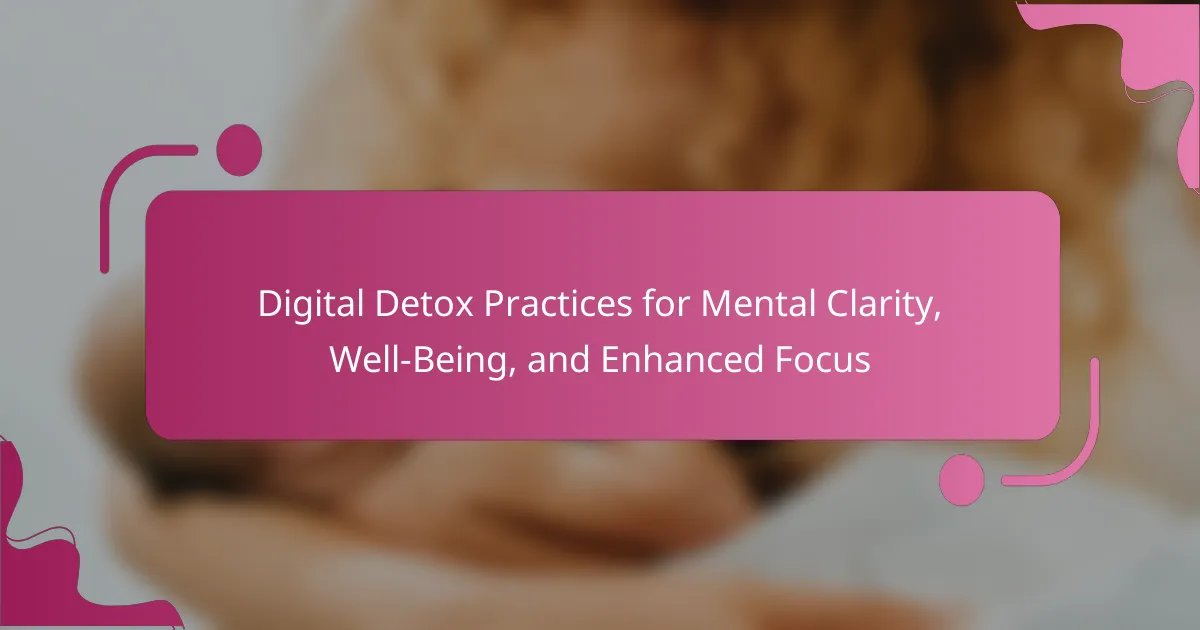Digital detox practices enhance mental clarity and well-being by reducing distractions and stress. These strategies improve focus and promote mindfulness through intentional device-free activities. Regular detox can lead to better sleep quality and increased productivity, while also fostering deeper interpersonal connections. Understanding cultural influences on digital detox methods can further enhance their effectiveness.
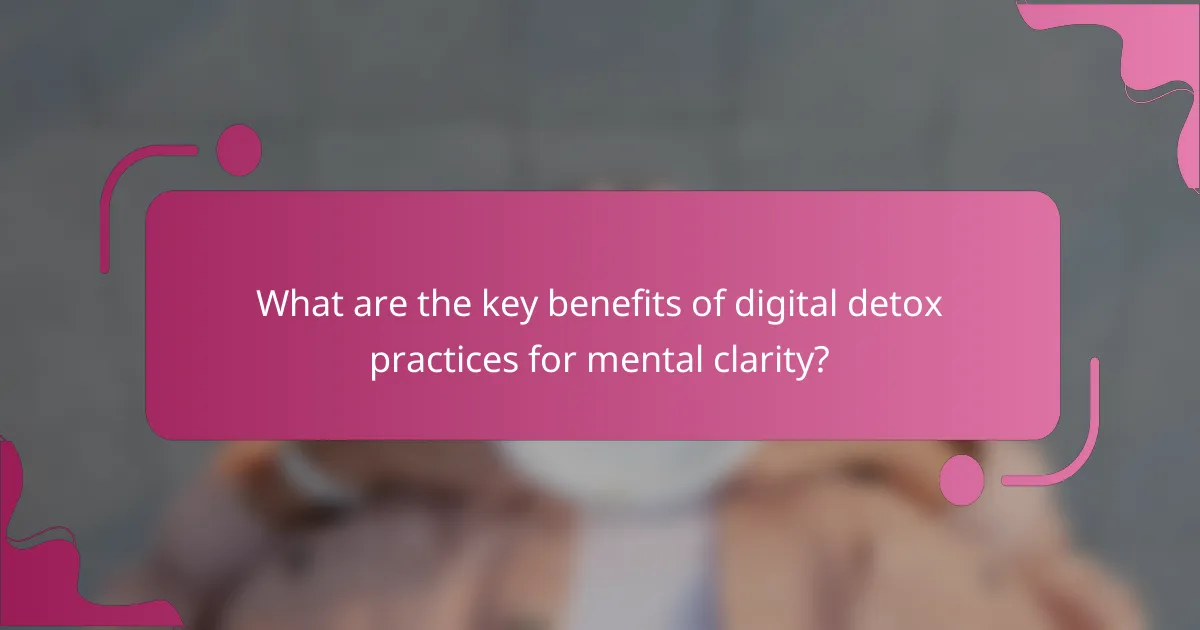
What are the key benefits of digital detox practices for mental clarity?
Digital detox practices enhance mental clarity by reducing distractions and stress. These practices promote mindfulness, allowing individuals to focus on the present moment. Regular digital detox can lead to improved concentration, better sleep quality, and increased productivity. Studies show that taking breaks from screens can significantly lower anxiety levels and enhance overall well-being.
How does reducing screen time improve focus and concentration?
Reducing screen time significantly enhances focus and concentration by minimizing distractions and mental fatigue. Limiting exposure to screens fosters better cognitive function and promotes mindfulness. Studies show that individuals who engage in digital detox practices report improved attention spans and better task completion rates. This practice allows the brain to recharge, leading to increased productivity and mental clarity.
Which mental health improvements are associated with digital detox?
Digital detox practices significantly enhance mental clarity, well-being, and focus. Users often report reduced anxiety, improved mood, and better concentration after disconnecting from digital devices.
A study found that spending just one week without social media can lead to heightened feelings of happiness and connection with others. Participants experienced a 50% drop in feelings of loneliness.
Digital detox allows for increased mindfulness, fostering deeper personal connections and enhancing creativity. Engaging in nature or hobbies during this period can further amplify these benefits.
By reducing screen time, individuals can regain control over their thoughts and emotions, leading to a more balanced and fulfilling life.
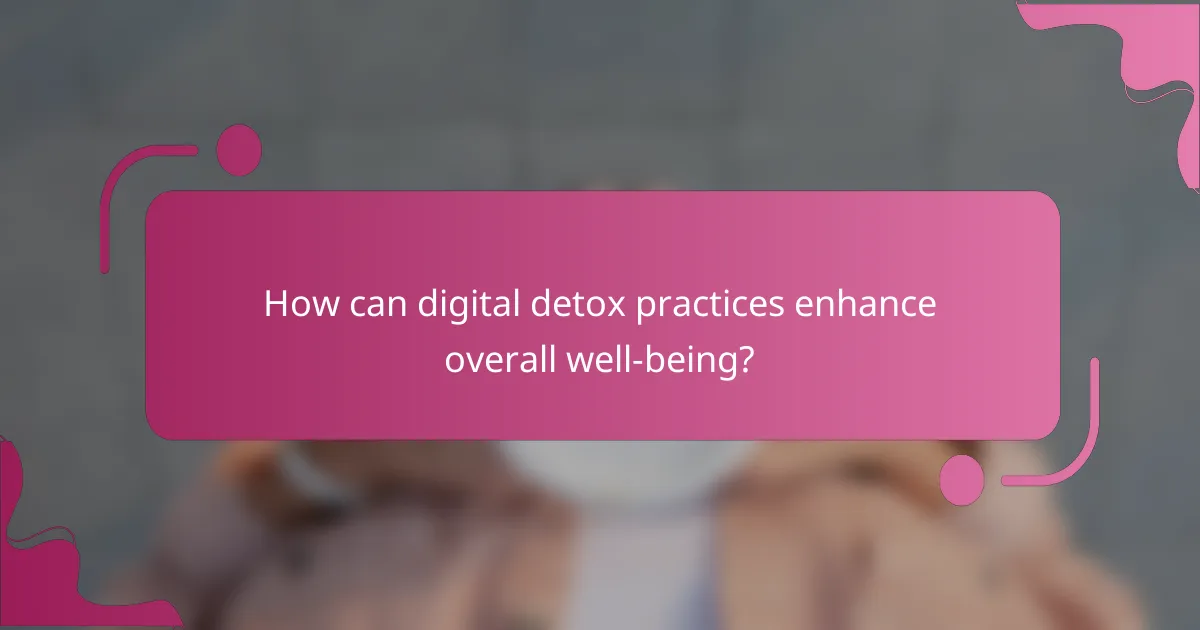
How can digital detox practices enhance overall well-being?
Digital detox practices significantly enhance overall well-being by promoting mental clarity and improved focus. Engaging in regular digital detoxes reduces stress and anxiety, allowing individuals to reconnect with their thoughts and surroundings. Research indicates that limiting screen time can lead to better sleep quality and increased productivity. For instance, a study found that participants who practiced digital detox experienced a 30% improvement in their concentration levels. Additionally, these practices foster deeper interpersonal connections by encouraging face-to-face interactions, which are often diminished by excessive device usage. Overall, integrating digital detox into daily routines can lead to a more balanced and fulfilling life.
What role does mindfulness play in digital detox strategies?
Mindfulness plays a crucial role in digital detox strategies by enhancing mental clarity and focus. It encourages individuals to engage in the present moment, reducing distractions from digital devices. Practicing mindfulness during a digital detox can lead to improved emotional well-being and decreased anxiety. Techniques such as meditation, deep breathing, and mindful observation help individuals reconnect with their surroundings and thoughts, fostering a sense of calm. By integrating mindfulness into digital detox practices, users can cultivate a more balanced relationship with technology.
How do digital detox practices affect sleep quality?
Digital detox practices significantly improve sleep quality by reducing screen time and promoting relaxation. This reduction helps to lower blue light exposure, which disrupts melatonin production. Studies indicate that participants in detox programs report better sleep duration and increased sleep efficiency. Engaging in activities like reading or meditating during detox can further enhance these benefits, leading to overall improved mental clarity and well-being.
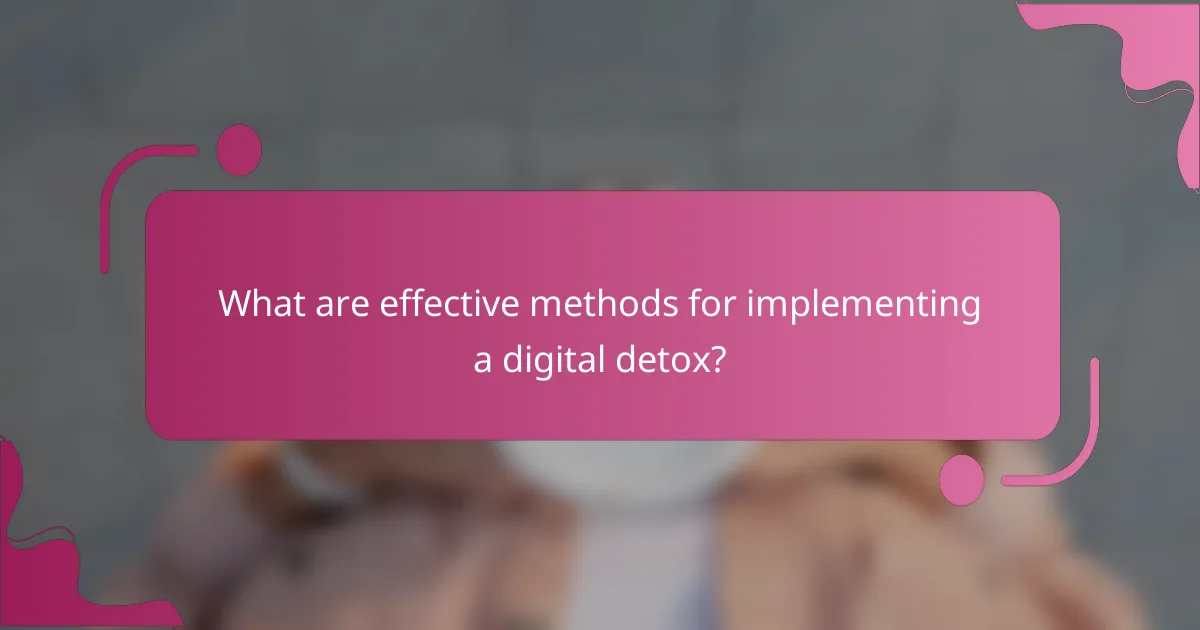
What are effective methods for implementing a digital detox?
Implementing a digital detox effectively requires intentional strategies. Start by setting specific times for device-free activities. Schedule regular breaks from screens, such as during meals or before bed. Engage in offline hobbies, like reading or exercising, to enhance mental clarity. Establish tech-free zones in your home to foster a more mindful environment. Consider using apps that track and limit screen time to support your detox goals.
Which specific activities can replace screen time during a detox?
Engaging in physical activities, creative pursuits, and mindfulness practices can effectively replace screen time during a detox. Consider outdoor activities like hiking or cycling, which enhance mental clarity and well-being. Creative options include drawing, writing, or playing a musical instrument, fostering focus and self-expression. Mindfulness practices such as meditation or yoga promote relaxation and cognitive clarity, supporting overall mental health.
How can setting boundaries with technology lead to a successful detox?
Setting boundaries with technology fosters a successful detox by reducing distractions and enhancing mental clarity. Establishing limits on device usage allows for increased focus on personal well-being. This practice can lead to improved mood and reduced anxiety levels. Research indicates that digital detox can enhance productivity by up to 40%. Prioritizing face-to-face interactions during this period strengthens social connections and emotional health.
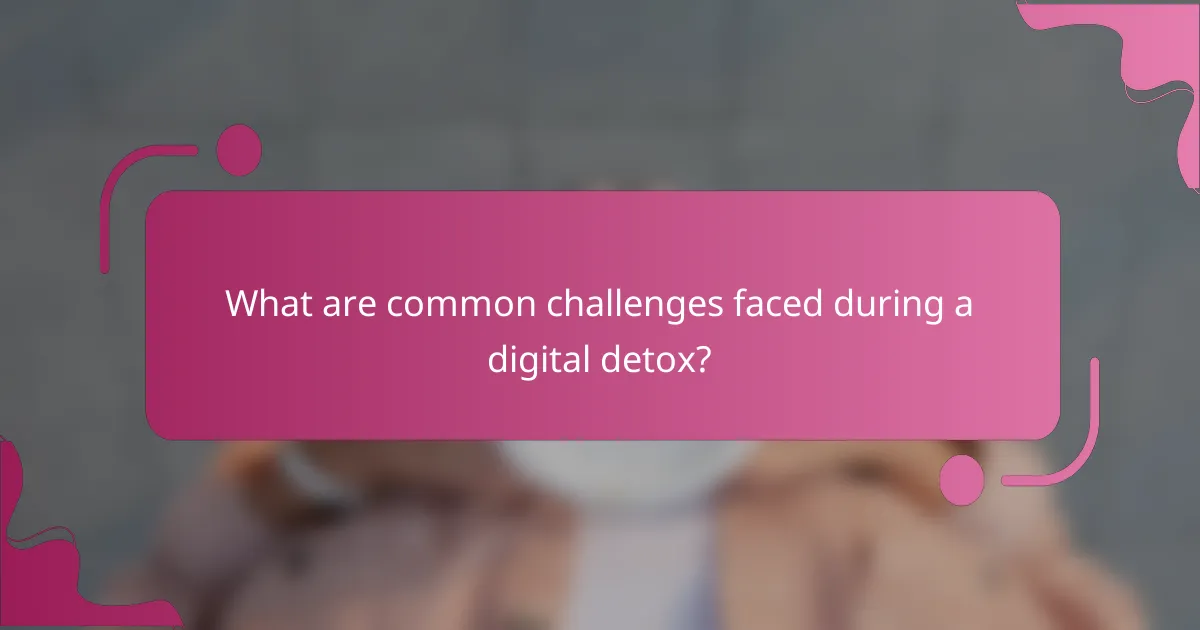
What are common challenges faced during a digital detox?
Common challenges during a digital detox include withdrawal symptoms, social pressure, and difficulty in maintaining focus. Users often experience anxiety, restlessness, or boredom without digital devices. Social expectations can create stress, making it hard to disconnect. Additionally, habitual reliance on technology for information and entertainment complicates the detox process.
How can individuals overcome withdrawal symptoms from technology?
Individuals can overcome withdrawal symptoms from technology by implementing structured digital detox practices. Start by setting specific time limits for device use. Gradually increase offline activities such as reading, exercising, or engaging in hobbies. Establish tech-free zones in your home to create physical boundaries. Practice mindfulness techniques to enhance mental clarity and focus. Seek support from friends or groups to share experiences and strategies for coping. These practices foster well-being and help individuals regain control over their tech habits.
What strategies help maintain motivation throughout the detox process?
Establishing clear goals and a supportive environment helps maintain motivation during a digital detox. Setting specific, achievable objectives fosters a sense of purpose. Engaging in mindfulness practices enhances self-awareness, promoting resilience against distractions. Regularly tracking progress reinforces commitment and celebrates milestones, maintaining momentum throughout the detox process.
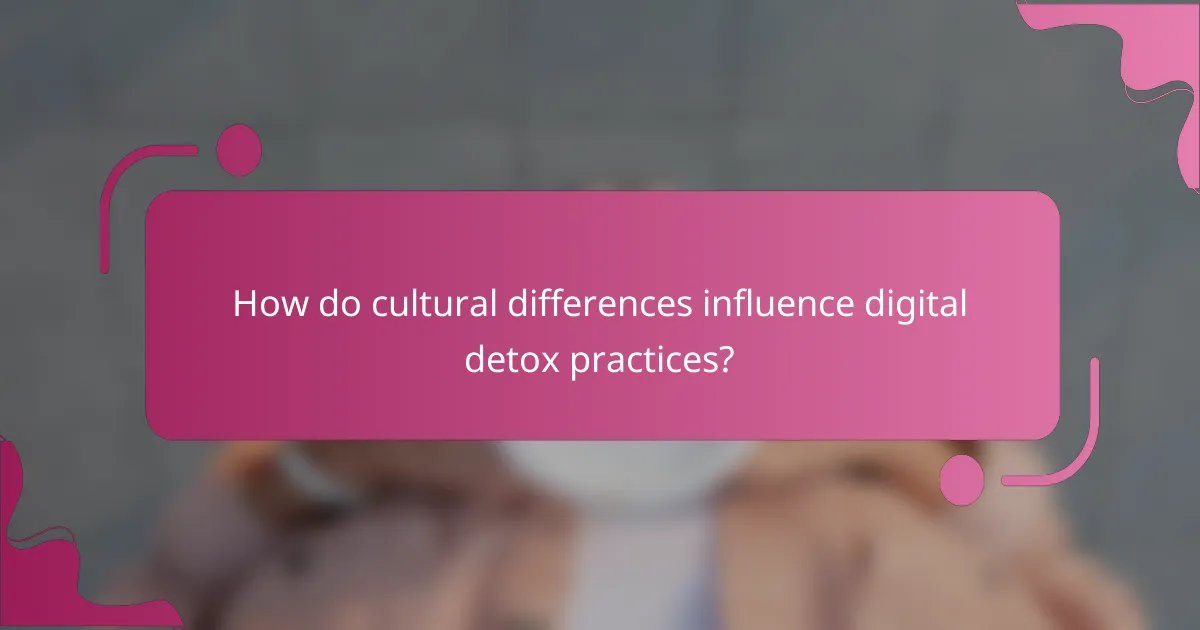
How do cultural differences influence digital detox practices?
Cultural differences significantly shape digital detox practices by influencing attitudes toward technology use. In collectivist societies, community-oriented detox methods, such as group retreats, are common. In contrast, individualistic cultures often emphasize personal strategies, like solo retreats or mindfulness practices. Additionally, cultural norms dictate the perceived necessity of digital detoxing, with some cultures viewing it as essential for mental well-being, while others may see it as unnecessary. The duration and frequency of detox practices also vary, reflecting local lifestyles and values. Understanding these cultural nuances enhances the effectiveness of digital detox strategies.
What unique approaches to digital detox are seen in different regions?
Different regions adopt unique digital detox practices to promote mental clarity and well-being. In Scandinavia, nature immersion through forest bathing is common, enhancing focus and reducing stress. In Japan, the concept of “shinrin-yoku” emphasizes reconnecting with nature, leading to improved mental health. In the United States, tech-free retreats focus on mindfulness and meditation, fostering a deeper connection to self. In South Korea, digital detox camps encourage participants to engage in activities like hiking and art, promoting creativity and relaxation. Each approach reflects cultural values and aims to improve overall mental health through reduced digital engagement.
How do societal expectations shape technology use and detox efforts?
Societal expectations significantly influence technology use and detox efforts. People often feel pressured to stay connected, leading to increased screen time and diminished mental clarity.
Social norms dictate constant availability, impacting well-being and focus. Many individuals engage in digital detox practices to counteract these pressures, seeking mental clarity and improved focus.
Research shows that regular breaks from technology can enhance cognitive function and emotional health. For instance, a study found that reducing screen time by 50% led to a notable increase in productivity and overall satisfaction.
In summary, societal expectations shape how individuals interact with technology, prompting detox efforts that aim to restore balance and enhance mental well-being.
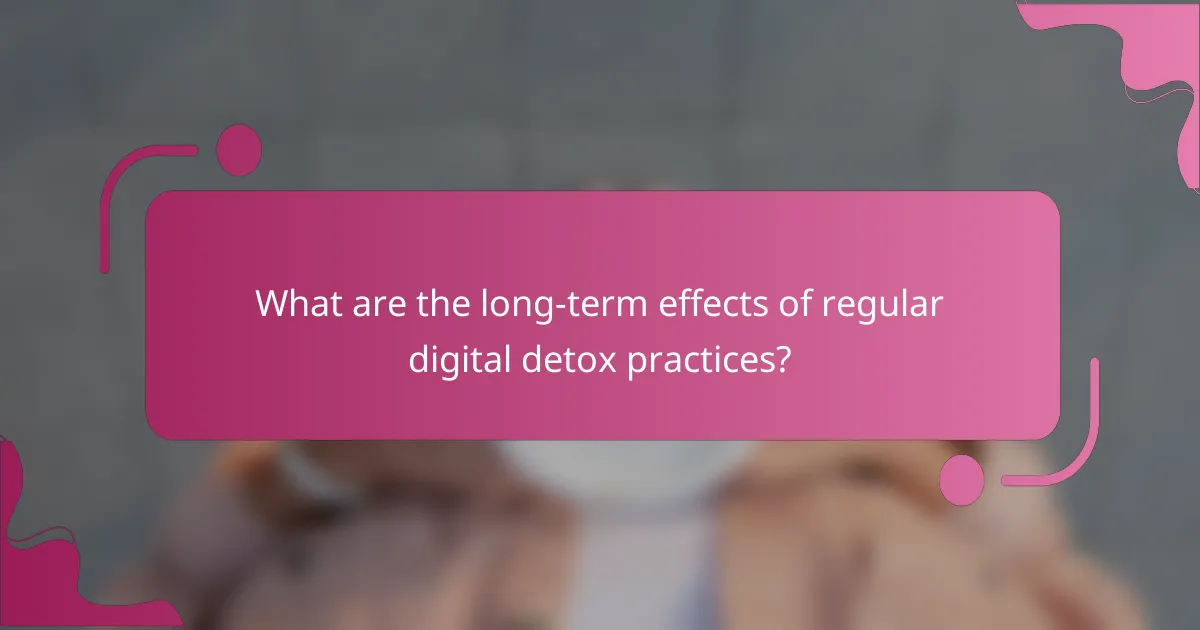
What are the long-term effects of regular digital detox practices?
Regular digital detox practices lead to improved mental clarity, enhanced focus, and better emotional well-being over time. Participants often report decreased anxiety and increased productivity. Research indicates that reducing screen time fosters deeper connections with others and promotes mindfulness. Long-term commitment to digital detox can enhance cognitive function and improve sleep quality, contributing to overall health.
How does consistent digital detox contribute to sustained mental clarity?
Consistent digital detox enhances mental clarity by reducing cognitive overload. It allows the brain to reset, improving focus and decision-making. Regular breaks from screens can lower stress levels, fostering a sense of well-being. Studies show that limiting digital exposure can enhance creativity and productivity, leading to sustained mental clarity over time.
What evidence supports the benefits of ongoing digital detox routines?
Ongoing digital detox routines significantly enhance mental clarity, well-being, and focus. Studies indicate that regular breaks from screens reduce anxiety and improve cognitive function. For instance, a research review found that participants reported a 40% increase in productivity after engaging in digital detox practices. Furthermore, a survey revealed that 70% of individuals felt more relaxed and focused post-detox. These practices encourage mindfulness, leading to better emotional regulation and stress management.
What expert tips can enhance the effectiveness of digital detox practices?
To enhance the effectiveness of digital detox practices, establish clear boundaries and set specific goals. Schedule dedicated detox periods to disconnect from devices and engage in mindfulness activities. Incorporate nature walks to reduce stress and improve mental clarity. Limit social media usage by unfollowing distracting accounts. Create a technology-free zone at home to foster a peaceful environment.
